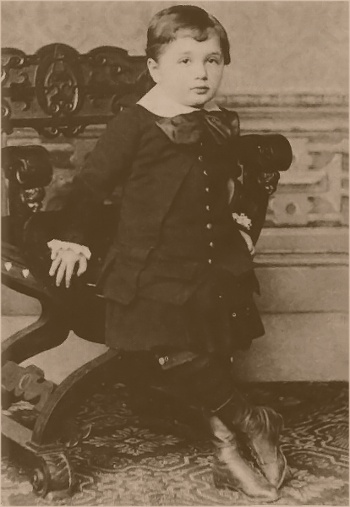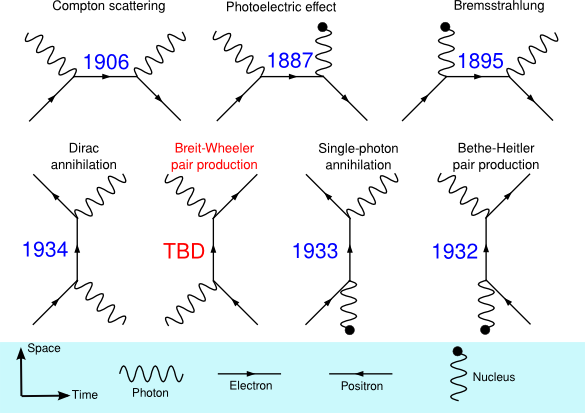Mass-Energy Equivalence
June 2, 2014
As
Scott Adams has proved in his popular "
Dilbert"
comic strip, people in
technology enjoy
humor that's directed at their
profession. There's also the mostly
mathematics/
computer science themed
xkcd comic of
Randall Munroe. Long before Dilbert, and Munroe's
stick figure philosophers,
Sidney Harris was publishing
science-themed
cartoons in
magazines such as
American Scientist. I have quite a few
books by Sidney Harris on my bookshelf.[1-2]
One memorable Sidney Harris cartoon shows
Albert Einstein at a
chalkboard. He's written
E = ma2, crossed it out, then
E = mb2, and crossed that out. You can see a copy of the cartoon,
here. It's the cover image of one of his books.[1] Harris has also published a book entitled, "Einstein Simplified," containing cartoons on many science subjects, not just Einstein.[2]

Albert Einstein in 1882, three years of age.
This is the oldest known photograph of Einstein.
(Wikimedia Commons image, modified for artistic effect.)
Einstein's discovery of
mass-energy equivalence probably didn't happen that way. Not only that, but his
publication of this principle didn't contain the
E = mc2 equation; instead, Einstein wrote
L = mc2, where L is the
Lagrangian.[3]
The
Lagrangian, is a useful concept in
classical mechanics. It's the difference between the
kinetic energy (T) and the
potential energy (V) of a system; i.e., L = T - V. The mass-energy equivalence principle, as expressed in an
English translation of his paper, is
"The mass of a body is a measure of its energy-content; if the energy changes by L, the mass changes in the same sense by L/9 x 1020 , the energy being measured in ergs, and the mass in grams."[3]
The conversion of mass to energy is most apparent in the
explosion of a
thermonuclear weapon, and it happens all the time on a smaller scale in
nuclear processes such as
radioactive decay. The inverse process of energy conversion to mass is also observed in
particle accelerators, although not in the
de novo creation of matter, but in the increased mass of existing
particles. The
de novo creation of matter from
light is predicted by
quantum electrodynamics, which is one of the most successful
theories of
modern physics. The true creation of matter from energy is likely the mechanism of the
Star Trek transporter
Physicists from the
Blackett Laboratory of
Imperial College (London, UK) and the
Max-Planck-Institut für Kernphysik (Heidelberg, Germany) have recently proposed an
experiment to demonstrate light-to-matter conversion based on a mechanism known as
Breit–Wheeler pair production.[4-9] In 1934,
American physicists,
John Archibald Wheeler and
Gregory Breit, observed that it's possible for two
photons to combine to produce an
electron and a
positron.[5,9] Wheeler and Breit thought that their process would never be seen in a
laboratory, but that was before we had such technology as high energy
lasers and accelerators.[5,9]
There was one experiment at the
Stanford Linear Accelerator Center (SLAC,
Stanford, CA) in 1997 that gave indirect evidence for Breit–Wheeler pair production. In that experiment, a high energy laser was directed at an accelerated beam of electrons which
reflected some of the photons back into the incident laser beam. This allowed an interaction between high energy photons, and the
data indicated that electron-positron pairs were produced.[8]

The six demonstrated ways, and one theorized way, in which photons and matter can interact. Original Imperial College London image by Oliver Pike, redrawn for clarity)
Breit-Wheeler pair production is one of seven fundamental ways that light and matter interact (see figure). It's interesting to note that the other six are all associated with a
Nobel Prize.[5] What the
British-
German team proposes is a photon–photon collider in which a
gamma ray beam is directed at a high-temperature radiation field in a
hohlraum (
German for "empty room") excited by intense laser radiation.[4]. This idea emerged from discussions of
laser fusion.[5-6]. Says team member,
Oliver Pike,
"Within a few hours of looking for applications of hohlraums outside their traditional role in fusion energy research, we were astonished to find they provided the perfect conditions for creating a photon collider."[5]
The photon-photon collider would operate in a two-step process. First, an ultra-high-intensity laser accelerates electrons to nearly the
speed of light. These electrons are directed to a
gold target, and the resultant impact produces an intense photon beam. This beam is directed to the interior of the hohlraum, a small can made also from gold, that has been laser-excited to create intense
thermal radiation in its interior. Collisions of the photons will create an estimated 100,000 electron-hole pairs.[4-8]
The research team hopes to do the actual experiment within the year.[6-7,9] The experiment would need to be done at one of the few sites with such capability. These include the
OMEGA Laser at the
University of Rochester (Rochester, New York)
,[6-7,9] and a laser at an atomic weapons facility in
Aldermaston, Berkshire, UK.[9]
This experiment will simulate a process presumed important in the first hundred seconds of the
universe, and also in present day
gamma ray bursts.[5] The research was funded by the
Engineering and Physical Sciences Research Council, the
John Adams Institute for Accelerator Science, the
Atomic Weapons Establishment, and the Max-Planck-Institut für Kernphysik.[5]
References:
- Sidney Harris, "What's So Funny About Science?: Cartoons from American Scientist," William Kaufmann, June 1977, ISBN-13: 978-0913232392, 120 pp. (via Amazon).
- Sidney Harris, "Einstein Simplified, Revised Edition: Cartoons on Science," Rutgers University Press, February 25, 2004, ISBN-13: 978-0813533865, 160 pp. (via Amazon).
- A. Einstein, "Ist die Trägheit eines Körpers von seinem Energieinhalt abhängig?", Annalen der Physik, vol. 18, no. 13 (1905). A PDF file of an English translation (Does The Inertia Of A Body Depend Upon Its Energy-Content?) can be found here.
- O. J. Pike, F. Mackenroth, E. G. Hill and S. J. Rose, "A photon–photon collider in a vacuum hohlraum," Nature Photonics, Advance Online Publication, May 18, 2014, DOI:10.1038/nphoton.2014.95.
- Gail Wilson, "Scientists discover how to turn light into matter after 80-year quest," Imperial College Press Release, May 19, 2014.
- Megan Garber, "How to Take Light and Make Matter," The Atlantic, May 19 2014.
- Rebecca Jacobson, "Scientists hope to make matter from light, proving Einstein's theory," PBS, May 19, 2014.
- Pete Spotts, "How to make matter from light? Physicists propose ingenious tool," Christian Science Monitor, May 20, 2014.
- Ian Sample, "Matter will be created from light within a year, claim scientists," The Guardian (UK), May 18, 2014.
Permanent Link to this article
Linked Keywords: Scott Adams; Dilbert; comic strip; technology; humor; profession; mathematics; computer science; xkcd comic; Randall Munroe; stick figure; philosopher; Sidney Harris; science; cartoon; magazine; American Scientist; book; Albert Einstein; blackboard; chalkboard; photograph; Wikimedia Commons; mass-energy equivalence; scientific literature; publication; Lagrangian; classical mechanics; kinetic energy; potential energy; English language; translation; mass; energy; erg; gram; explosion; thermonuclear weapon; atomic nucleus; nuclear; radioactive decay; particle accelerator; elementary particle; electromagnetic radiation; light; quantum electrodynamics; theory; modern physics; Star Trek transporter; physicist; Blackett Laboratory; Imperial College (London, UK); Max-Planck-Institut für Kernphysik (Heidelberg, Germany); experiment; Breit–Wheeler pair production; American; John Archibald Wheeler; Gregory Breit; photon; electron; positron; laboratory; laser; Stanford Linear Accelerator Center; Stanford, CA; reflection; data; Feynman diagram; Oliver Pike; Nobel Prize; Great Britain; British; German; gamma ray; hohlraum; German language; inertial confinement fusion; laser fusion; speed of light; gold; thermal radiation; OMEGA Laser; University of Rochester (Rochester, New York); Aldermaston, Berkshire, UK; universe; gamma ray burst; Engineering and Physical Sciences Research Council; John Adams Institute for Accelerator Science; Atomic Weapons Establishment.